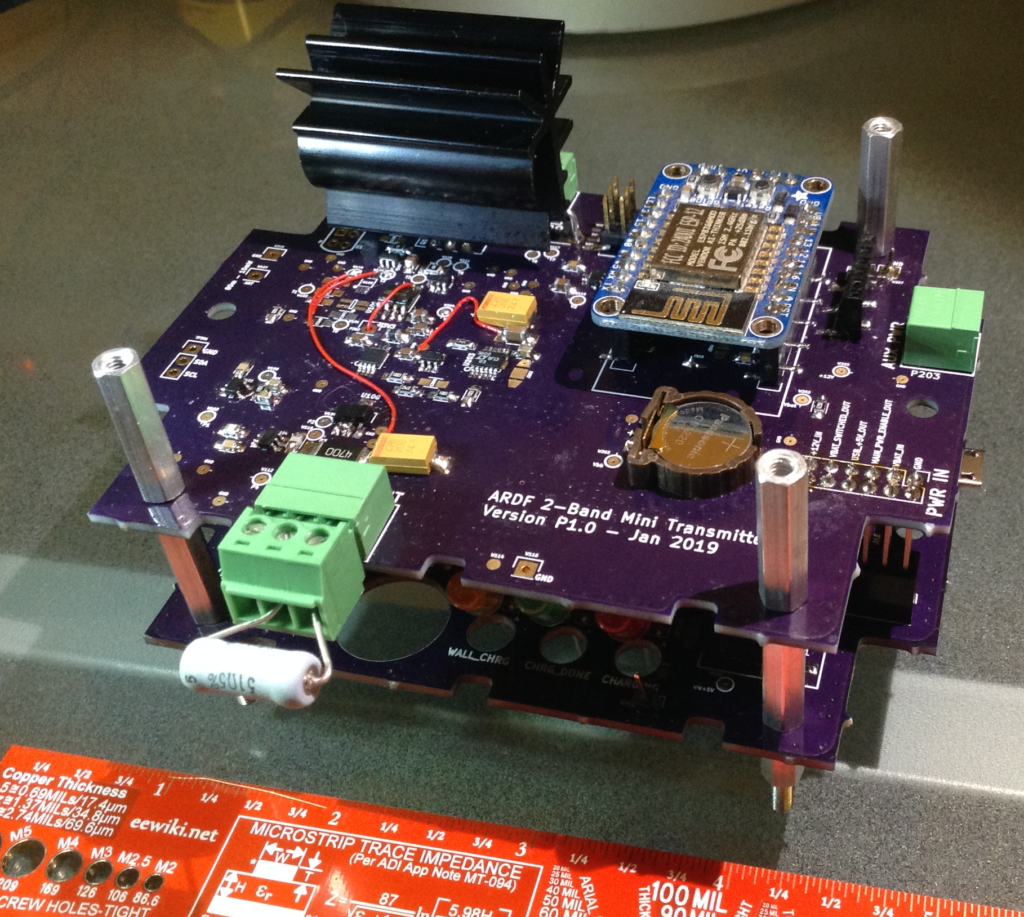
Photo description: A transmitter board is shown stacked on top of a power supply board in the original dual-band transmitter concept. The small board riding on top of the transmitter board is the WiFi module that will serve to provide the human interface via a smartphone, tablet, or computer. The WiFi interface and the 80m transmitter design are carried over to the FlexiFox.
Transmitters Concept
The philosophy was to have one ARDF transmitter type that does everything on both the 2m and 80m ARDF bands. Although that concept has some desirable features, it proved more expensive than necessary. Also, having separate 2m and 80m transmitters has the advantage that it supports having two events going on simultaneously on two different bands.
Instead of a dual-band ARDF transmitter, one transmitter type for each band is now the path forward. The 2m band will be handled by Arducon: an Arduino-based ARDF transmitter controller that can transform any FM HT into a 2m AM ARDF transmitter. The 80m band will be handled by FlexFox80: a flexible 80m CW transmitter design that can handle all power levels between 10mW and 5W.
FlexiFox 80m ARDF Transmitter Concept
The firmware running a FlexiFox transmitter will store a series of ARDF events that can be scheduled to occur over multiple days. The control operator callsign, dates, and times of each event, along with frequencies and power levels, will be stored in non-volatile memory in each transmitter. All event information can be programmed into one transmitter using a PC, or a smartphone, then shared amongst all the transmitters by a simple cloning process. The event information needs to be updated only once per event, or whenever event plans change.
A keyed antenna connector allows transmitters to shut off automatically when the antenna is removed, as well as when the scheduled stop time is reached.
Each transmitter has its own precision real-time clock that drifts by less than 1 second in three days. The transmitter clocks can be synchronized automatically during the cloning process, or whenever a transmitter is configured over WiFi.
Power Supply
Rather than providing an internal battery as the power source, FlexFox will provide a standard PowerPole connector for attaching an external battery. Lightweight LiIon battery packs are available at reasonable prices. FlexFox will accept any battery providing between 5V and 13.8V DC at 1 amp or greater. That includes most LiIon battery packs, as well as SLA batteries.
Future Flexibility
Rather than using software that is hardwired for today’s ARDF competition formats, FlexiFox defines how events are conducted using event scripts stored in its flash file system. ARDF practice formats, or future 80m competition formats can be uploaded over WiFi: no reprogramming of the microcontroller is required.
Hardware Documentation Coming Soon
Prototype FlexFox80 transmitters have been built and tested since early 2019. They are a proven design and use the venerable ATMEGA328P (Arduino) processor. But lower cost and better performance can be had with a more capable processor, so the AVR128DA48 has been chosen as the path forward. Very few hardware changes are planned, but of course, the new processor will require a redesigned PCB.
Since a new PCB design is required, the decision was made to bring in some of the features of Arducon, allowing FlexFox80 to be remotely controlled by simply attaching a VHF or UHF handheld walky-talky. The Arducon features will also allow the FlexFox80 to be configured using DTMF tones, a browser over WiFi, or by attaching an FTDI cable between the FlexFox80 and a computer.
All the software and hardware design has been thoroughly tested in Arducon and in the early FlexFox prototypes. So not much is new here, but FlexFox80 will bring everything together in a relatively small, inexpensive, and very reliable package.
Software development for the FlexFox80 is in progress. You can follow along, or even contribute here: https://github.com/OpenARDF/FlexFox80. Software development is being done on the AVR128DA48 Curiosity Nano development board. Go to the AVR128DA48 branch on GitHub to access the code developed for that processor.
